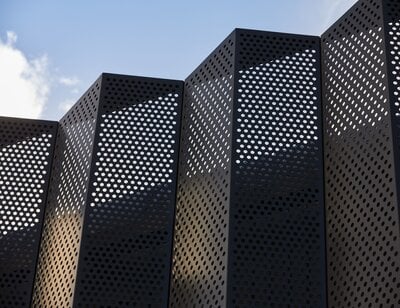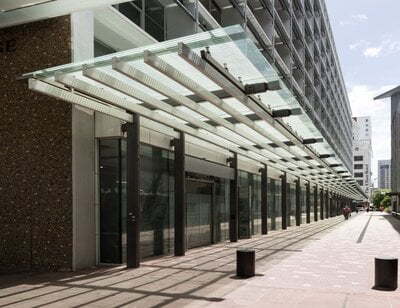Acoustic Comfort in Architecture
In a previous blog we explored the financial and physical effects of wind. That article was focused on the escalating threat of wind as we push the boundaries of architectural facade design, buildings grow taller and weather patterns more extreme. Centred on the mitigation and litigation of any adverse complications for the developer and architect, it did not explore the effect on building occupants, whose frustrations would give rise to the need for arbitration and possible legal action.
So here we explore the issues of acoustic comfort in architecture. Whilst we are particularly interested in aeroacoustic issues associated with facades, we’ll cover the general effects of acoustic comfort and what it means for those inside, or nearby, a building that whistles, whines or makes an otherwise unwanted noise.
What is Acoustic Comfort?
Acoustic comfort is defined as the psychophysical condition where a person, in a specific environment, experiences a sense of well-being in relation to a specific activity. In other words, how comfortable you are at home when relaxing while reading a book. Or enjoying dinner with guests. Or simply lying in bed and hoping for a few hours of blissful sleep. It’s important to note acoustic comfort is not the absence of noise. Rather, it’s being comfortable with what noise there is.
Acoustic comfort will differ from setting to setting, and person to person. For example, what you consider to be acceptable levels of noise in a library are likely very different from an airport. Which means the predictability of the sound, even the familiarity of the sound, have an impact. Then there are any personal sensitivities. These range from the obvious, like being noise sensitive, to not liking the sound coming from the neighbours...because you don’t like the neighbours.
The Physical Effects from Poor Acoustic Comfort
The scenario is this. A recently constructed apartment block has some louvres on the exterior for both solar control and aesthetics. They have a rounded profile and are placed close together, wrapping the corners of the apartment building, which we know to be a high wind zone. When the wind is coming from just the right direction, at the right speed, the louvres are ‘played’ but it’s not a tune anyone wants to hear. Rather, it’s a high pitched tonal whine akin to nails being raked across an old fashioned chalkboard. What’s the impact on the occupants?
What some may find surprising is noise is strongly associated with an increase in blood pressure and cardiovascular disease. For example, studies by the World Health Organisation have found people who live on or near very frequented streets, have a 20% higher chance of suffering a heart attack compared to those living on a quiet street. Live near an Airport? You’re at greater risk of suffering from obesity.
The risks are particularly pronounced at night time when everything else falls quiet and our expectations for acoustic comfort change. As parents will know only too well, the disrupted sleep from a demanding and vocal baby can make you pour coffee onto your cornflakes as you wander around in a constant daze, with what feels like a perpetual headache.
The Mental Effects from Poor Acoustic Comfort
The mental manifestations of poor acoustic comfort range from simple irritability to a more general malaise and decreased feeling of well-being. Indeed, let’s assume our example of the noisy louvres continues without solution for a period of time. It would be entirely plausible to suggest it would lead to increased levels of anxiety and the onset of depression in the affected occupants. There may also be panic attacks and significantly elevated stress levels.
Where the above is present it can lead a person to act erratically and elevate the potential for violence. If that sounds overly dramatic, then consider this: ‘sound torture’ (the playing of loud music or white noise for continued periods) is actually a thing and has been reportedly used by Governments. Sure, that’s at the far end of the spectrum for acoustic comfort but it does highlight the serious consequences of unwanted noise. Indeed, that such extremities on the spectrum even exist is somewhat disconcerting. But, in the interests of balance we should highlight the growing use of sonic therapies in treating everything from PTSD to Parkinson's Disease. So the spectrum does have a ‘good’ end also.
Acoustic Comfort and Productivity
Let’s place our fictional apartment resident at work. The consequences of sleep deprivation from tonal noise are obvious on productivity levels. Anyone so tired they put coffee on cornflakes is unlikely to churn out the most accurate set of accounts, or have the concentration to produce a highly detailed drawing.
Placing our by now bedraggled fictional character to one side, let’s assume the tonal noise is coming from a facade on an office block. Inside, there is a team trying to go about their work. The unwelcome and unfamiliar tonal noise invasion is likely to be highly distracting, reducing attention spans, accuracy and overall productivity.
Taking it a step further, noise is strongly correlated to absence due to sickness. In other words, the toll from noise (be it through stress or anything else) is a contributor to increased sick days.
Acoustic Comfort and Learning
It will be no surprise that as for the workplace, the same holds for the classroom (which we might view as the students workplace). That is, where there are poor levels of acoustic comfort, lack of focus and irritability are present. Indeed, this might be a more pronounced issue in the classroom given the ability of a single irritated student to disrupt and distract an entire class, thus having a disportionately negative effect on all occupants. The resultant drop in academic performance is accentuated in mathematical and language disciplines, where high levels of attention are required. Given the fundamental importance of both subjects, improving acoustic comfort in classrooms is obviously very important.
We should also draw attention to the plight of the teachers. On a physical level, sickness due to voice ailments really is an issue. And that’s without the elevated stress from having to manage a teaching space occupied by irritable students.
The Future
So where does this leave us? We need to look at the future of inner city developments and the growing awareness of the role noise plays in our life.
There is an inevitability to the need for buildings to grow in height. The most populated metropolitan areas have limited space to develop out, so we develop up. It starts with apartment blocks and offices but it won’t stop with them. Vertical schools are a relatively recent development in Australia, likely to be followed in New Zealand cities at some point in the future. This proves that regardless of the ‘operation’ within a building, we will develop upwards towards the sky. Yes, rooftop playgrounds sound scary but might not be that unusual in the near future. This added height of buildings will only serve to increase the likelihood of tonal noise from building facades.
Add to this the increased awareness of the need to control acoustic comfort levels by the occupants. Be it from the School Principal following best practices for elevating education standards (no pun intended) or from the savvy CEO who wants to drive every last drop of productivity out of his team.
So, as added height and facade design pushes past the confines of current standards, occupants will be demanding reassurances of acoustic comfort levels. It’s yet another complication to throw into the design mix. And another risk to throw into the mitigation mix.
As a final thought, we could consider flipping everything around and in the future we actually use facades to enhance acoustic comfort. That is, where we don’t just test the facade for the noise it makes but rather its ability to suppress noise (testing it for the noise it doesn’t make). We might even go one step further. Imagine a facade with active noise cancellation properties (like your headphones) to cancel out noise for both occupants and for those on the street below. A plane flies overhead and no-one hears it, either inside the building or on the street. That could be something worth making a noise about.








